
Mosasaurs, Sharks, and Other Marine Creatures from the Cooperstown Pierre Shale Site
by John W. Hoganson, Michael Hanson, Dennis L. Halvorson, and Verla Halvorson
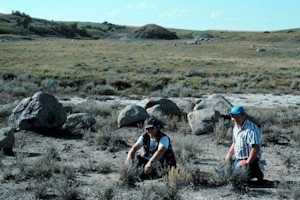
Fossil collectors with avocational interest in the science of paleontology have played a major role in the development of this science since fossils were first recognized as being the remains of prehistoric life. A few years ago I received a telephone call from Mike Hanson, an electrician from Cooperstown, North Dakota stating that he and a friend, Dennis Halvorson, Cooperstown's resident plumber, had discovered some fossil bones in the Sheyenne River valley south of Cooperstown (Figure 1). I visited Mike and Dennis in Cooperstown and discovered that they had found vertebrae, teeth, and other mosasaur bones in the Cretaceous age Pierre Shale. Mosasaurs were giant marine lizards that inhabited the Western Interior Seaway that covered most of North Dakota, including Cooperstown, about 75 million years ago (Figure 2). Isolated occurrences of mosasaur bones had been reported from the Pierre Shale in eastern North Dakota previously, and I did not view Mike and Dennis' fossils of particular significance but asked them to keep me apprised of any additional discoveries. Shortly thereafter that they began to find the remains of marine fishes, particularly sharks, and invertebrate animals with the mosasaur fossils. My interest in the site was simulated by these new finds and Mike, Dennis, Dennis' wife Verla and I have been working together on fossils from this site since.
The Cooperstown site encompasses an area of about two square kilometers along the Sheyenne River southeast of Cooperstown, Griggs County, in a place referred to locally as the "Indian mounds". The name refers to the haystack shaped hills in the valley which were thought by some to be Indian burial mounds. These hills, however, are erosional remnants of the once much more extensive Pierre Shale rock formation. It is in these rocks that the most diverse assemblage of fossils ever found in the Pierre Shale in North Dakota is located. In this part of eastern North Dakota the landscape has mostly been sculpted by glacial processes. There are large glacial erratics (boulders) in this valley resting on Pierre Shale surfaces which were deposited thousands of years ago when the Sheyenne River valley was choked with flood waters from melting of the last continental glaciers. Erosion of the valley at that time and since has exposed one of the thickest sections of Pierre Shale in the state. The lower part of the section, measured from the level of the Sheyenne River, consists of 4.5 meters of the Gregory Member of the Pierre Shale. It is overlain by 38 meters of the DeGrey Member of the Pierre Shale. The Gregory Member consists of light brown to tan, calcareous claystone. Yellow-brown ironstone concretions occur in this member. The Gregory is highly fossiliferous and has yielded many different kinds of invertebrate fossils. The DeGrey Member is a light to dark gray noncalcareous shale. Thin beds (one to 15 centimeters thick) of very light gray bentonite (altered volcanic ash) occur throughout the DeGrey but are more common in the lower 6 meters of the member. Black, iron-manganese carbonate and light gray, phosphatic concretions are common in the lower part of this member. These concretions are often fossiliferous containing fragments of clams and other invertebrates. The upper 24 meters of the DeGrey Member is obscured by vegetation and glacial drift containing erratics that cap the hills. The remains of mosasaurs and other marine vertebrates are found in the bottom 7.5 meters of the DeGrey Member.
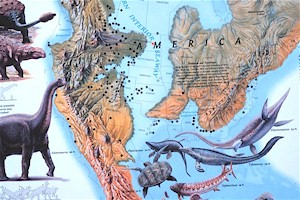
Screen washing of the fossiliferous claystones of the Gregory Member has yielded an extensive array of invertebrate fossils of creatures that inhabited the Pierre Sea (Figure 3 ). This fauna includes foraminifera (one celled organisms that secrete minute shells), bryozoa (lace animals -- Figure 4A), brachiopods (Lingula -- Figure 4B corals (Micrabacia -- Figure 4C and others -- Figure 4D ), scaphopods (tusk shells), clams (Inoceramus, Nucula -- Figure 4E , Nuculana, Pteria, Nemodon? -- Figure 4F , oysters, and many others), snails (Margaritella -- Figure 4G, Trachytriton -- Figure 4H , Atira, Oligoptycha, Graphidula?, and many others' -- Figure 4I, cephalopods (Baculites gregoryensis -- Figure 4J & 4K, Didymoceras -- Figure 4L , Solenoceras mortoni -- Figure 4M), annelids (worm tubes), crustaceans (the crab Dakoticancer, the lobster Hoploparia, the shrimp Callianassa -- Figure 4N , and the tiny bivalved crustaceans called ostracodes), star fish -- Figure 4O , and sea urchins (Eurysalenia -- Figure 4P & 4Q). The Cooperstown site is the only place in North Dakota where many of these kinds of fossils are found although similar fossil faunas have been recovered in South Dakota and Wyoming. These fossils suggest that the Pierre Sea, in the Cooperstown area 75 million years ago, was shallow and warm. The cephalopods indicate that the Gregory Member at the Cooperstown site is middle Campanian in age. That is, these rocks (including the fossil shells) were deposited on the floor of the Pierre Sea about 75 million years ago (Figure 5).
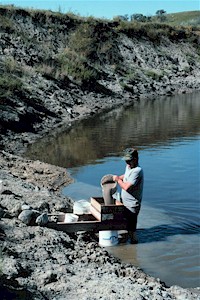
|
Figures 4A-4Q. Fossils of invertebrate animals recovered from the
Gregory Member of the Pierre Shale. |
|||
|---|---|---|---|
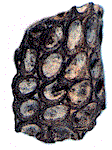 4A. Bryozoa (height 3 mm) |
 4B. Brachiopod (Lingula) height 3 mm |
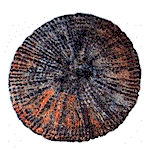 4C. Coral (Micrabacia) width 4 mm |
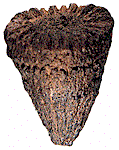 4D. Coral height 11 mm |
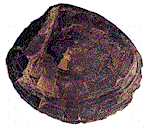 4E. Clam (Nucula) width 17 mm |
 4F. Clam (Nemodon?) width 3 mm |
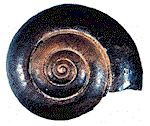 4G. Snail (Margaritella) width 8 mm |
 4H. Snail (Trachytriton) height 20 mm |
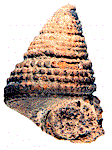 4I. Snail height 12 mm |
 4J. Cephalopod (Baculites gregoryensis, adult) length 55 mm |
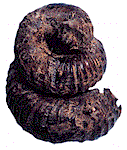 4L. Cephalopod (Didymoceras) height 27 mm |
 4M. Cephalopod (Solenoceras mortoni) height 19 mm |
 4K. Cephalopod (Baculites gregoryensis, juvenile) length 11 mm |
|||
 4N. Shrimp (Callianassa, claw) length 20 mm |
 4O. Starfish (single plate) height 7 mm |
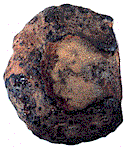 4P. Sea Urchin (Eurysalenia) width 7 mm |
 4Q. Sea Urchin (Eurysalenia spine) height 4 mm |
Several kinds of interesting fossils of vertebrate animals are found in the lower part of the DeGrey Member, just above the fossil bed containing the invertebrate fossils. These fossils provide information about the kinds of vertebrate animals that inhabited the Pierre Sea. Included are the teeth of several different kinds of sharks such as Squalicorax (extinct cow shark -- Figure 6A), Pseudocorax (another extinct cow shark -- Figure 6B), Cretolamna (Figure 6C ), Carcharias (sand-tiger shark -- Figure 6D and Western Interior Seaway Painting), and Squalus (dogfish shark -- Figures 6E & 6F ). The remains of bony fish are also present in the DeGrey, including the teeth of the salmonlike Enchodus (Figure 6G and Western Interior Seaway Painting). A tarso-metatarsal bone of the hesperornithid bird Hesperornis was also found in this interval (Figures 6H & 6I). Hesperornis was a large, up to about two meters tall, flightless seabird (Western Interior Seaway Painting). This bird was equipped with sharp, pointed teeth and probably preyed on fast-moving fish and squids underwater. Although this bird was incapable of flight, it was a swift swimmer that propelled itself through the shallow, coastal waters of the Pierre Sea with its powerful hind legs similar to the modern loon. Coprolites, fossilized excrement, are trace fossils found at the site (Figure 6J). These fish and birds existed with the large marine reptiles, the mosasaurs, that inhabited the Pierre Sea.
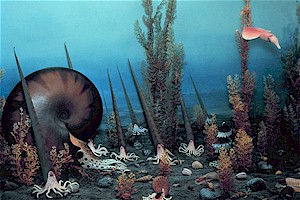
| Figure 6A-6J - Fossils of vertebrate animals recovered from the DeGrey Member of the Pierre Shale. |
|||
|---|---|---|---|
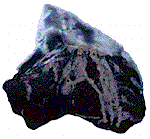 6A. Shark tooth (Squalicorax) width 20 mm |
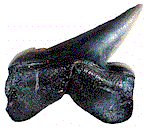 6B. Shark tooth (Pseudocorax) width 10 mm |
 6C. Shark tooth (Cretolamna) height24 mm |
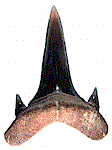 6D. Shark tooth (Carcharias) height 10 mm |
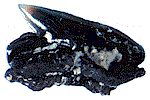 6E. Shark tooth (Squalus) width 6 mm |
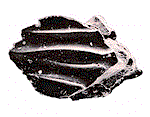 6F. Shark placoid scale (Squalus) width 1 mm |
 6G. Salmon like fish tooth (Enchodus) height 4 mm |
 6J.Coprolite, fossilized excrement length 31 mm |
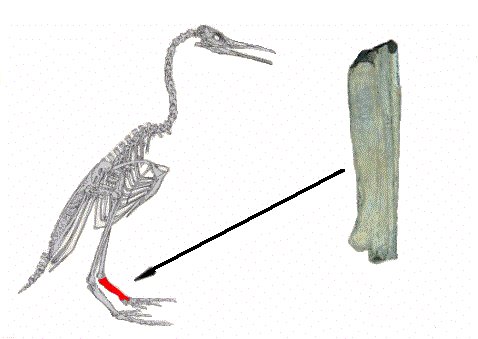 6I. Tarso-metatarsal of a Hesperornis bird length 90 mm 6I. Tarso-metatarsal of a Hesperornis bird length 90 mm6H. Diagram of a Hesperornis bird skeleton (from Carroll, 1988) height 2 m |
|||
The remains of twelve mosasaurs have been found in the lower part of the DeGrey Member from an area of about one-square kilometer at the Cooperstown site. Fossils of two kinds of mosasaurs, Plioplatecarpus and an unidentified mosasaurine, are present. Mosasaurs were marine lizards that inhabited tropical to subtropical oceans, like the Pierre Sea, in coastal areas with water depths of probably less than 100 fathoms (90 meters) during the last part of the Cretaceous Period (Western Interior Seaway Painting). They, like the last of the dinosaurs, became extinct at the end of the Cretaceous, about 65 million years ago. Although they were large reptiles, and lived at the same time as dinosaurs, they were not dinosaurs and were most closely related to the living varanid (monitor) lizards (e.g., Komodo dragon of Indonesia). Like many dinosaurs, however, many mosasaurs were huge animals with long lizard-like bodies attaining lengths in excess of 7.5 meters (Figure 7A). Unlike their terrestrial lizard relatives, the limbs of mosasaurs were modified to form flippers. Mosasaurs swam by lateral undulations of the posterior part of their elongate bodies and laterally compressed tails. Their flippers were used primarily for steering rather than for propulsion as the animal glided through the water. The shape of the skeleton of Plioplatecarpus suggests that it was probably a slow but agile swimmer, similar to the living seal. Mosasaurs were active carnivores and among the main predators in the Pierre Sea as attested to by their large jaws studded with sharp, conical teeth (Figures 7B &7C). They probably preyed on other mosasaurs, fish, turtles, cephalopods and other invertebrates. It has been suggested that mosasaurs relied on highly developed senses of sight and smell to locate and catch their prey.
 7A. Diagram of a mosasaur skeleton similar to the ones found at the Cooperstown site (From Russell, 1967). |
||
 7B. Lower jaw of excavated Plioplatecarpus length 550 mm |
 7C. Tooth of excavated Plioplatecarpus height 70 mm |
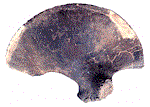 7D. Shoulder blade of excavated Plioplatecarpus width 308 mm |
Until last fall, the only mosasaur remains found at the Cooperstown site were isolated vertebrae, teeth, other small skeletal parts. While exploring the far western portion of the Pierre outcrop area at the site, Mike and Dennis discovered a eight-centimeter-long section of mosasaur jaw, with teeth, beginning to weather out of the Pierre Shale on a small hill (Figure 8). Johnathan Campbell (the Survey's fossil preparator) and I traveled to Cooperstown expecting to spend 2 or 3 hours at the site extracting the jaw from the rock. Four days later we were still there excavating what was beginning to emerge as a fairly complete mosasaur skeleton. We had to terminate the dig because of bad weather, but returned to the site this July to complete the excavation. As expected, most of the skeleton was preserved, the most complete mosasaur skeleton ever found in North Dakota. It is difficult to determine at this point exactly how complete the skeleton is because the bones were removed in two very large and several smaller plaster field packages (blocks of rocks containing the fossil bones are encased in plaster casts before removal to help preserve the fragile bones -- Figures 9-12 ). The lower jaws with teeth (Figure 7B), disarticulated skull, first 20 vertebrae (articulated), shoulder blades (Figure 7D), coracoids, and front and back flipper elements are present and many other bones are hidden in the field packages. Preservation of the bones is excellent allowing us to identify the skeleton as a six- to eight- meter-long specimen of the mosasaur called Plioplatecarpus.
We have begun preparation and study of the fossils from this important Pierre Shale site and have presented some preliminary results of our findings (Figure 13 and see additional readings below). These fossils provide a glimpse of what life was like in the shallow, subtropical sea that covered the Cooperstown area. It was obviously teaming with life reflected by the variety of fossils found at the site. We expect to learn more as work continues on the fossils.
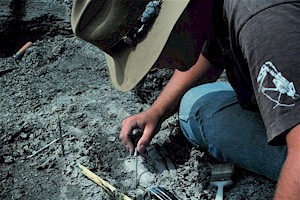
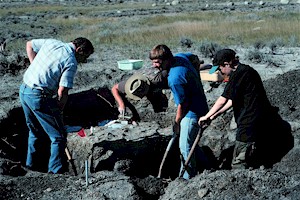
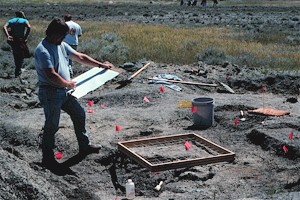
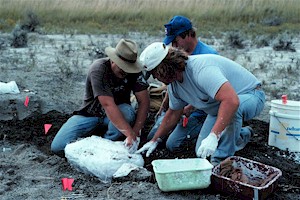
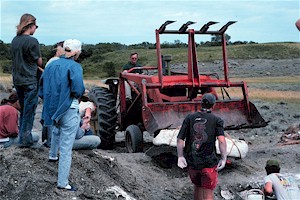
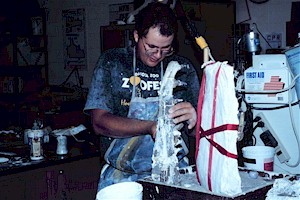
One of the intriguing questions is how the mosasaurs at this site may have died. Is it possible that these animals all died at about the same time, suffocated by volcanic ash? The mosasaur bones are found in the Pierre Shale associated with layers of bentonite, altered volcanic ash. Did volcanic eruptions far to the west create enough air fall ash in North Dakota to decimate the mosasaur population in the Pierre Sea? We are also interested in how these animals interacted as a community. During preliminary cleaning of some of the mosasaur bones, teeth (Figure 6E ) and placoid scales (Figure 6F) of dogfish sharks were found with the mosasaur bones. Sharks often loose their teeth while feeding. Could it be that dogfish sharks scavenged this mosasaur carcass? Or, perhaps the mosasaur preyed on the dogfish sharks and these teeth and scales are undigested residues. Hopefully we will be able to answer some of these questions.
Mike, Dennis, Verla, and I would like to thank Orville and Beverly Tranby and family and the Tim Soma family for allowing us to collect and study fossils from their property (Figure 14). These fossils are currently in our laboratory at the North Dakota Heritage Center in Bismarck for curation and study. Most of the fossils, however, will eventually be exhibited at the Griggs County Museum in Cooperstown. We believe that the Plioplatecarpus mosasaur skeleton is complete enough to restore as a three dimensional skeletal mount exhibit. Because of the importance of this specimen, Orville and Beverly and Beverly's sisters, Mrs. Gloria Thompson, Mrs. Jacqueline Evenson, and Mrs. Susan Wilhelm have decided to donate this fossil to the North Dakota State Fossil Collection for study and exhibit at the Heritage Center. We thank them forthis donation as it will be an educational and a popular exhibit that will be viewed by many. Chris Dill, State Historical Society of North Dakota and Museum Director of the Heritage Center, enthusiastically supports a mosasaur exhibit and has given us the authorization to proceed with the exhibit plans. A fossil restoration project such as this is a major and expensive undertaking and will be accomplished only through private donations. If any of you are interesting in financially supporting the restoration of the Cooperstown mosasaur for exhibit at the Heritage Center please contact me.
Hoganson, J. W., Hanson, Michael, Halvorson, D. L., and Halvorson, Verla, 1996, Stratigraphy and paleontology of the Pierre Shale (Campanian), Cooperstown site, Griggs County, North Dakota: Proceedings of the North Dakota Academy of Science, v. 50, p. 34.
Hoganson, J. W., Hanson, Michael, Halvorson, D. L., and Halvorson, Verla, 1996, Mosasaur remains and associated fossils from the DeGrey Member (Campanian) of the Pierre Shale, Cooperstown site, Griggs County, east central North Dakota: Geological Society of America, Rocky Mountain Section, abstracts with programs, v. 28, no. 4, p. 11-12.;
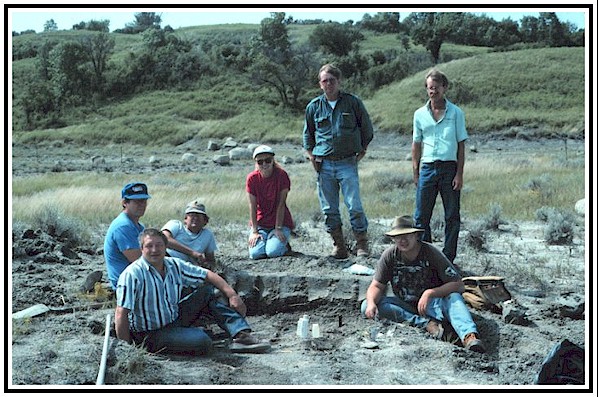
Johnathan Campbell, and Scott Tranby at the mosasaur excavation site.
